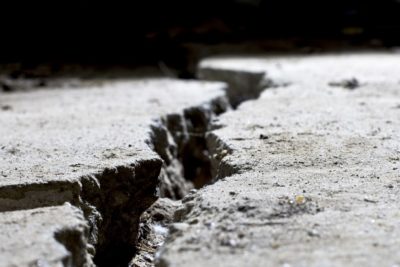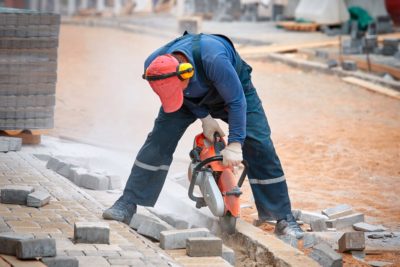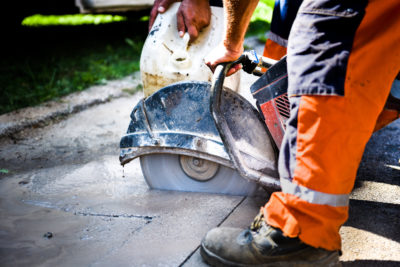Dust can be a serious problem on construction and mining sites. It’s almost inevitable that there will be at least some dust present on your site, but too much dust can be harmful.
Where dust is breathed into the lungs, it can cause serious health problems for the workers. But it can also cause environmental problems, as well as legal problems for your company if you are not controlling the dust levels sufficiently.
But you can control the amount of dust using the right dust mitigation techniques, from the use of vegetation to wet cutting. Here’s a look at the problem of dust on construction and mining sites and what you can do about it.
Types of Dust on a Site
There are lots of different types of dust that you might find on a site as a byproduct of various activities. Some of these dust types are more harmful than others.
Silica dust
Silica dust is one of the most dangerous types of dust, and it is also very common. Silica occurs in lots of types of construction materials like cement, mortar and sand, so it’s no surprise that it is often present on construction sites.
When cutting concrete or carrying out other tasks like drilling or demolition tasks on mining sites, silica dust is a risk you need to be aware of.
non-silica dust
Non-silica dust is not as dangerous as silica dust, but it can still be harmful. Again, non-silica dust is present in several construction materials like cement, limestone and gypsum, and the dust is created by various tasks including cutting and drilling.
Wood dust
If you are working with wood on construction sites, you should also be aware of wood dust. This type of dust is created when working with both soft and hard wood when carrying out tasks like cutting or sanding, and it is very common.
The Risks Posed by Dust on Construction and Mining Sites
The primary concern when it comes to dust is the health risks it poses to people working on the site. It can be dangerous when people are exposed to a lot of dust in a short period of time, but dust can also cause health problems when people are exposed to smaller amounts of dust over many months and years.
Silica dust can have serious health consequences. When people are exposed to large amounts of silica dust either in a short time or over longer periods, the smallest particles can enter the lungs and settle. This can cause problems like chronic obstructive pulmonary disorder (COPD) and silicosis, which is found in people exposed to silica dust over time.
Dust can also cause less serious problems like irritation to the eyes and throat that can make working more difficult, leading to productivity issues. It can also be more serious for asthmatics and anyone suffering from allergies.
As well as the health concerns posed by the production of dust, it can also lead to problems for your company. Workers who suffer health problems as a result of being exposed to dust may seek compensation, leading to liability issues.
Dust can also have environmental consequences in the form of air pollution, which can affect people in the immediate vicinity and surrounding areas.
Dust Mitigation Techniques
Because dust can cause serious problems, it needs to be controlled. You need to ensure it does not pose a risk to workers or to the environment. So what can you do? Here are some of the most important dust mitigation techniques to follow.
Reduce Affected Areas
Proper planning is essential to reduce the amount of dust on the site. The goal should be to limit the amount of soil disturbance as much as possible during the work. That means only disturbing the minimum amount of area at one time. If less area is affected, the amount of dust produced will be minimised too.
Water
The application of water is one of the most commonly used dust control measures on construction sites. It can be used in various ways and provides a cheap and highly effective option that has very good results.
Where there is dry, dusty ground on the site, the dust can lift up and blow on the wind. Using water to make the ground wet can prevent this from happening, reducing the amount of dust and preventing it from being blown away.
You might use a water tanker on-site to spray water onto the area regularly, which can be an effective option for roads to prevent vehicles from disturbing the dust and in turn prevent it from going airborne. Water may need to be applied multiple times a day to have the desired results.
Water also plays a role in techniques like wet cutting. Wet cutting is an important dust control method when cutting concrete. Instead of cutting through dry concrete, water is hosed directly onto the cutting blade as it rotates. Water mist is also sprayed into the air, which helps the dust to settle sooner.
Wet cutting can reduce the amount of dust generated when cutting concrete by a significant amount, in some cases by as much as 85%. It also has other benefits, one of which is reducing the temperature of the cutting blade, keeping the blade cool so it lasts longer and produces more precise cuts.
Vegetation
Another good option is to use vegetation and mulch to reduce the amount of dust that is exposed to the air. Where soil is exposed, the dry dust can easily be spread by the wind. Exposed soil is affected by erosion both from the wind and water, and the vegetation helps to keep it in place, providing a greener dust control solution.
Wind erosion can be reduced significantly by planting vegetation, reducing the amount of airborne dust. Where vegetation already exists on and around the site, try to keep as much as possible in place. Where there is no vegetation, consider planting some. Less bare soil means less dust.
Stone
Stone is often used on construction roads and on the entrances to sites as a good alternative to vegetation where this is not an option. Large stones are used to cover the soil, and they can help to prevent the dust from being carried and spread on the wind.
Physical Barriers
One of the problems when it comes to dust control is preventing it from being transferred from one place to the other, often by the wind. Physical barriers can play an important role here.
Erecting a board fence, sediment fence or other barriers like this can reduce the effect of the wind and prevent it from moving the dust, helping to keep the dust on site and preventing it from being blown elsewhere.
Dust Extraction
Often it is not possible to reduce the amount of dust produced by a certain task, and dust extraction has an important role to play in this situation.
High-powered vacuums fitted with air filters can be used when cutting concrete, drilling or sawing, for example. Dust extraction equipment must be designed for the specific tool it is being used with in order to capture all of the dust effectively. Dust collection bags and filters should also be cleaned and changed regularly for the best results.
Chloride
Chloride can be used to retain moisture for longer periods of time, and it can therefore be a useful technique to prevent too much dust from being created. Chlorides are used to stabilise road surfaces that have not been paved, helping to keep the dust down.
Sweep Equipment
On roads and highways in and around construction and mining sites, dust can often be a problem. Sweep equipment can be used to clean up the debris to reduce the amount of dust. But be careful about airborne dust being produced during the sweeping process, which can be made worse. Despite this, it is another tool that you can consider using in your fight against dust.
Polymers
Where there are areas that are not being used for vehicles, polymers can be a good option. Dry applied polymers need to be watered for dust control, and they work by bonding the soil particles together and strengthening the soil’s surface. This can be very effective at reducing the amount of dust.
Tillage
Tillage is a technique that can be effective in some situations. It can only be used on flat areas, and it is a technique that roughens the soil using a special type of plough to create furrows, helping to reduce the amount of soil lost by wind erosion.
Work Outside
Where carrying out tasks that produce dust, consider working outside in exposed areas. This helps to reduce the amount of dust that is inhaled because it is less concentrated outside. It depends on the task and the specific situation, and it may not always be possible, but always look at ways of changing how you work to reduce exposure to dust.
Pay Attention to the Conditions
You should also pay close attention to the climatic conditions. For example, you may be planning to do some extensive earthmoving tasks. But if the day is particularly windy, it may be more suitable to postpone this task. You could save a lot of dust from being produced simply by changing the day you carry out the task, so always keep the conditions in mind.
Slow Down
There are some simple practices that can have a big impact on the amount of dust produced on a worksite, one of which is reducing the speed that the vehicles travel at. Where vehicles are travelling along unpaved roads, enforce a slower speed limit. Cutting the speed limit by just 10 mph can have a big impact on the amount of dust produced.
Choose Contractors Carefully
When hiring contractors to cut concrete, make sure you choose them carefully. This means choosing a contractor committed to maintaining a safe working environment and practising good dust control measures with a Concrete Sawing and Drilling Association Australia (CSDAA) membership.
They should invest in dust control equipment and techniques like wet cutting and the use of powerful wet vacuums, as well as use techniques like wire sawing that is relatively clean. Hiring qualified and experienced contractors that take sensible precautions can make a big difference in the amount of dust produced overall.
Provide Protection to Your Workers
Where dust is present, the first stage is always to try and reduce it. But even when you do everything possible, there may still be some dust present. It’s therefore important to provide your workers with personal protective equipment (PPE) to keep them safe.
Where dust is concerned, this usually means providing them with respiratory protective equipment. The right respirator for the job must be used, and you should ensure you are providing your workers with high-quality equipment that is comfortable to wear and does not get in the way of their work.
Workers will also require training to ensure they know how to use their equipment properly. Again, this should not be used in place of taking dust control measures, but it is an important additional safety measure.
Control Dust on Your Worksite
Dust may be unavoidable on construction and mining sites, but it is unpleasant, it can make working more difficult and it can also have serious health and environmental consequences. You have a duty to minimise dust on your worksite for the good of your workers and the environment, and you need to make sure you are doing all you can to reduce the amount of dust being produced by your activities.
As you can see, there are many dust mitigation techniques available, from simple techniques like wet cutting and reducing vehicle speeds to the planting of vegetation and using suitable dust extractors. You may need to use a combination of these techniques for the best results to ensure you are doing everything you can to reduce dust on the site.



